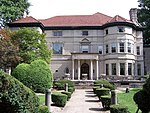Cicely L. Tyson Community School of Performing and Fine Arts
Cicely L. Tyson Community School of Performing and Fine Arts is a specialty magnet public middle school / high school that serves students in sixth through twelfth grades in the city of East Orange in Essex County, New Jersey, United States, as part of the East Orange School District, offering separate middle school and high school curricula. The school is named for actress Cicely Tyson. Students are accepted based on all their talents. The school teaches core disciplines while focusing on the creative potential of the students. As of the 2021–22 school year, the school had an enrollment of 732 students and 64.0 classroom teachers (on an FTE basis), for a student–teacher ratio of 11.4:1. There were 451 students (61.6% of enrollment) eligible for free lunch and 48 (6.6% of students) eligible for reduced-cost lunch.The school district, in partnership with the City of East Orange applied for and received a Demonstration Project Grant to build a new school. Between 2006 and 2009, Tyson Principal Mrs. Laura Trimmings, Washington Academy of Music Principal Mrs. Brenda Veale, the Mayor Robert Bowser and District Arts Coordinator Mrs. Iqua Colson worked with Ms Cicely Tyson on the design and curriculum for the project. In September 2009, Tyson's historic Elmwood Avenue building (formerly known as Vernon L. Davey Junior High) closed, and a new $180 million, 300,000-square-foot (28,000 m2) facility on Walnut Street (on the site of the former East Orange High School) took its place. The new facility, the Cicely L. Tyson Community School of Performing and Fine Arts, is among the largest and most technologically advanced schools ever built in the state of New Jersey, with extensive performing arts facilities which meet or exceed the highest professional standards. The school sits on a campus which consists of an elementary school and middle/high school. The school's 800-seat theater has been built to Broadway standards in terms of sound, lighting and acoustics. In addition to the school's theaters, students have access to a TV studio, art studios, music rooms, individual performance practice rooms, animation rooms and shops to build and design stage sets. The classrooms all feature smartboards, advanced integrated audio-visual systems, and multiple computer workstations.
Excerpt from the Wikipedia article Cicely L. Tyson Community School of Performing and Fine Arts (License: CC BY-SA 3.0, Authors).Cicely L. Tyson Community School of Performing and Fine Arts
Eppirt Street,
Geographical coordinates (GPS) Address External links Nearby Places Show on map
Geographical coordinates (GPS)
| Latitude | Longitude |
|---|---|
| N 40.7536 ° | E -74.221 ° |
Address
Cicely Tyson School of Performing and Fine Arts
Eppirt Street
07018
New Jersey, United States
Open on Google Maps






